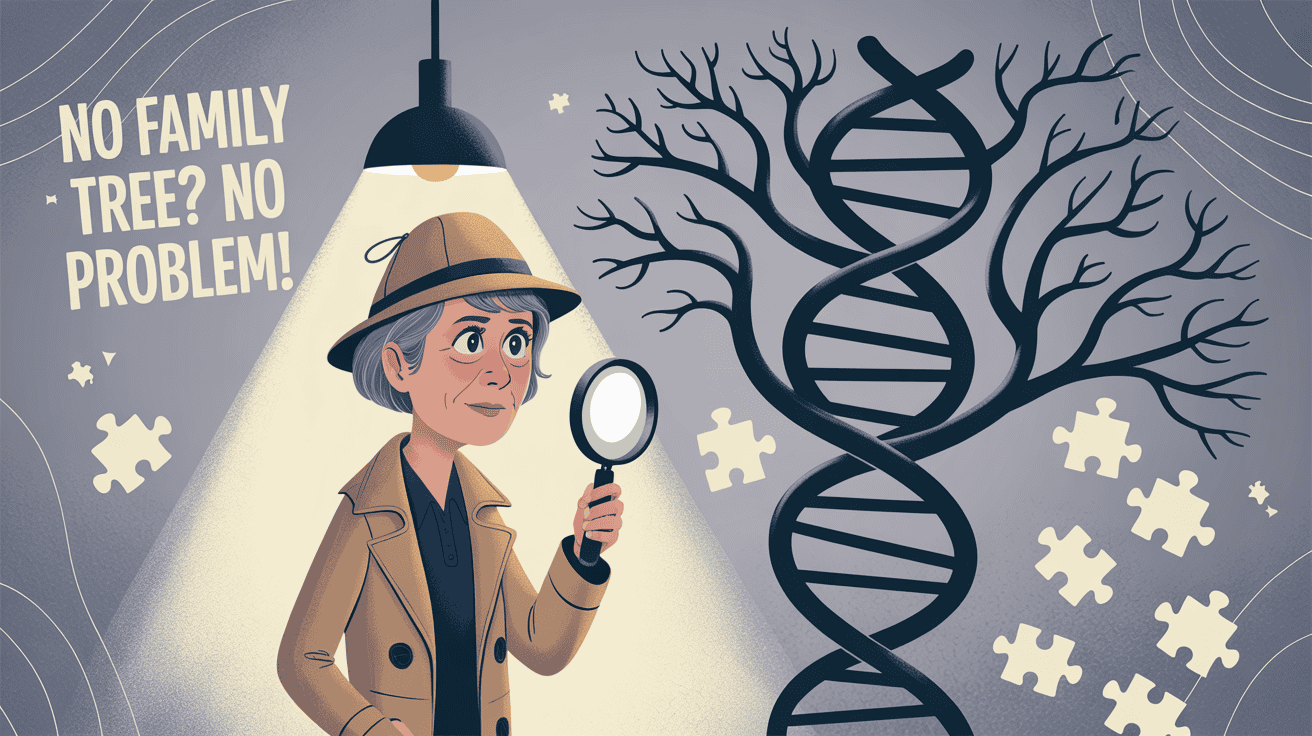You’ve taken a DNA test. The results arrived. Now you’re staring at a list of DNA matches.
Some have detailed family trees. Others? Ghost town.
And those messages you sent? Crickets.
But that doesn’t mean game over.
Far from it.
DNA matches without trees or responses aren’t dead ends—they’re mysteries waiting to be solved. And you’re about to become the detective.
Every unidentified match represents potential breakthrough connections. Missing puzzle pieces to your family story. Maybe even solutions to generations-old mysteries.
Think about it: that anonymous fourth cousin might hold the key to breaking down your biggest brick wall. The one that’s been frustrating you for years.
In this article, I’ll show you exactly how to unmask those silent DNA matches. These methods work even when traditional approaches fail.
No begging required.
Let’s dig in.
1. Maximize Platform Tools: Your First Line of Investigation
Never skip this step. The DNA testing platform itself is your richest source of initial clues.
Most people give up too easily. They see no tree, no “unlinked tree”, send one message, and move on.
Big mistake.
Start by examining the match profile in detail. Look for subtle clues hiding in plain sight. Usernames often contain parts of real names, birth years, or locations. JohnS1975_NYC tells you a lot more than you might realize.
Test administrators matter too. If someone else manages the kit, search for that person. They might have their own kit with a tree attached.
A name AND a location information is gold. Combined with an age range, this can be enough to find someone using people search sites. Once you have that foothold, look for deceased relatives.
Find their obituaries. Search them in the social security death index. Use these to reconstruct their family connections.
Search their name/location combo on facebook. Look at their about section. Are their family members listed?
Search their public comments. What hints do they drop about their location, age, or parents names?
Did they just wish their father a Happy Father’s Day, tagging him in the post?
Did their friends post of their profile wishing them a Happy Birthday last month? Note the date.
Stalkerish? Probably.
But sometimes it’s needed for those crucial DNA matches.
This strategy alone might be all you need.
Still no luck?
Move onto shared matches.
This feature shows you other people who share DNA with both you and your mystery match. It’s like getting a list of mutual friends.
If you have Ancestry Pro Tools, you hit the jackpot. It shows how much DNA your matches share with each other, not just with you. This reveals relationship patterns.
Look for your mystery match’s closest shared matches who have trees.
If they share ~700+ cM with someone who has a tree, you’ve struck gold. They’re likely first cousins or closer. That means your mystery match probably descends from one set of that person’s grandparents.
Connect these dots. Form theories. Test them.
Work smarter, not harder.
2. Username Archaeology: Tracing Digital Breadcrumbs
People are creatures of habit. They often use the same username across multiple platforms.
This is your advantage.
First, analyze the username itself. Break it down. A username like “JSmith1983_Boston” gives you a potential last name, birth year, and location.
Sometimes it’s more cryptic. “GardenGuru57” might reveal a hobby and age. Every detail matters.
Next, take that username hunting across the internet. Google is your best friend here. But don’t just type the username and hit search.
Use these power moves instead:
- Put the username in quotes for exact matching: “Username123”
- Use site-specific searches: site:facebook.com “Username123”
- Combine the username with other known information: “Username123” genealogy
Most people don’t realize you can also use people search sites to reverse search usernames and connect them to real identities.
Many people use the same username on genealogy forums, social media, and other sites. One hit can lead to a profile picture, real name, or family connections.
Remember: this isn’t about stalking. It’s about connecting the dots between your DNA and theirs. Building your family story requires detective work.
When you find a possible match, verify before proceeding. False positives happen. Confirmation is key.
3. People Search Sites: Your Secret Weapon for Finding Anonymous Matches
When platform tools and username searches hit a wall, people search engines become your ace in the hole.
Tools like Spokeo aggregate billions of records from public sources. It’s like having a research assistant who’s already done the hard work for you.
What can you find?
Current contact information. Past addresses. Known relatives. Social media profiles across 120+ networks. Property records. Court records.
It’s comprehensive.
Let’s say your DNA detective work has given you a potential name for your mystery match. Enter it into Spokeo’s search field. Within seconds, you’ll see possible matches with age ranges and locations.
Select the most likely candidate, and Spokeo reveals their connections. Family members. Associates. Address history.
This is where your DNA evidence and traditional genealogy converge.
Just remember: verify everything. Treat Spokeo’s information as leads, not conclusions.
Trust, but verify.
Building Reverse Trees: When You Need to Work Backward
Sometimes you need to build the puzzle from the outside in.
That’s where reverse tree building comes in.
Standard genealogy starts with you and works backward. Reverse genealogy starts with a suspected connection and works in multiple directions.
Here’s how to do it:
First, create a separate tree. Don’t contaminate your main research. This is a working hypothesis, not confirmed fact.
Start with what you know or strongly suspect. Maybe username archaeology led you to a likely name. Maybe shared matches suggest a common ancestor. Begin there.
Build wide, not just tall. Most DNA matches connect through collateral lines—siblings of your direct ancestors. Document all children of each couple, not just your direct line.
For maximum effectiveness, work backward to identify ancestors, then forward through all their descendants. Cast a wide net.
Use the information from shared matches as guide rails. If they all connect through your maternal grandmother’s family, focus your reverse tree building there.
Keep it private and unsearchable until confirmed.
Speculation has no place in public trees.
Document everything. Note where each piece of information came from. Label assumptions clearly. This keeps your research honest.
If you’re using Ancestry, their ThruLines feature can sometimes connect the dots between your private experimental tree and your DNA matches. It’s like having a second opinion on your detective work.
The process requires patience. But when that tree connects to your own—when you finally see exactly how that mystery match relates to you—the satisfaction is immense.
You’ve solved the puzzle. Connected the dots. Found family.
Ethical Considerations
With great power comes great responsibility.
These techniques work. But should you always use them?
Consider the privacy of others. Some people take DNA tests for medical reasons with no interest in connecting with relatives. Others may have complicated family situations.
Respect boundaries. If someone doesn’t respond to messages, they may have reasons. Your curiosity doesn’t override their privacy.
When you do identify a match and decide to reach out, be sensitive in your approach. Don’t lead with “I figured out who you are despite your privacy settings!”
Instead, mention shared ancestors or family lines. Focus on the genealogical connection, not your detective methods.
Some discoveries can be sensitive. Adoptions. Unknown paternity events. Family secrets. Handle these with extreme care and compassion.
Their tree could be empty for a reason.
Know when to stop. If all signs point to someone not wanting contact, respect that choice.
Remember: genealogy is about building bridges, not invading privacy.
Conclusion
Identifying anonymous DNA matches is both art and science.
It requires persistence. Patience. A methodical approach.
But the payoffs? Extraordinary.
Breaking down brick walls that have stood for generations. Connecting with family you never knew existed. Completing chapters of your family story that seemed forever lost.
These techniques work. I’ve seen genealogists use them to solve decades-old family mysteries. To find birth parents. To connect branches of family trees separated by oceans and generations.
Now it’s your turn. Look at your match list. Find that mysterious match that’s been bugging you. Apply these methods step by step.
Be patient. Be persistent. Be ethical.
And watch as those anonymous matches transform into named relatives with stories and connections that enrich your family history.
The mystery DNA match that frustrated you today might become your favorite genealogical discovery tomorrow.
The hunt begins now.


